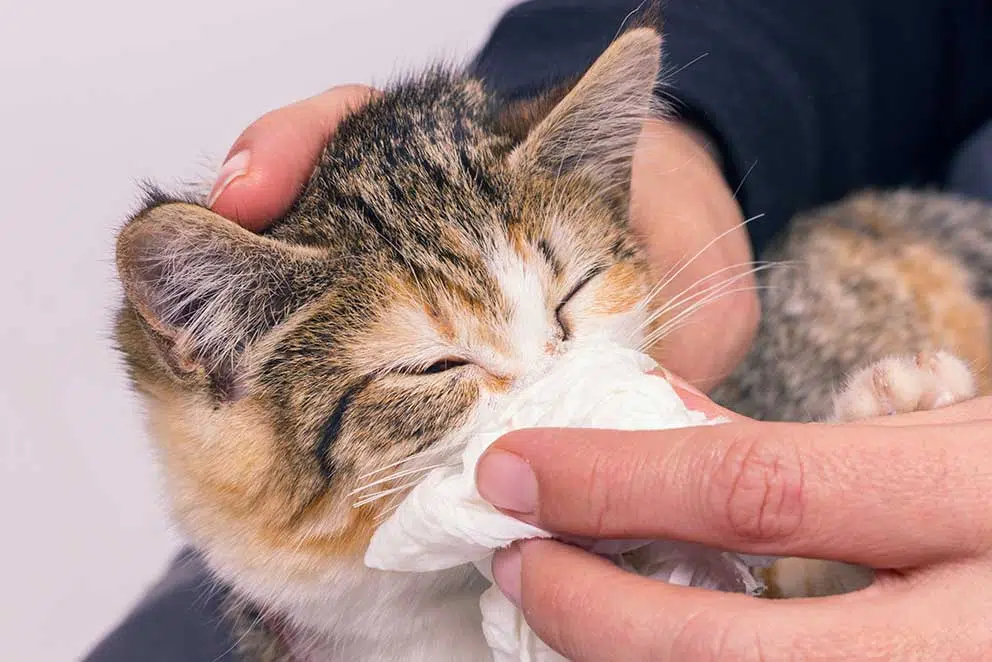Is Cat Flu Contagious to Humans?

Cat flu, also known as feline respiratory disease, is a viral infection that affects cats’ respiratory systems. As humans, we are used to the idea of getting sick from our peers whenever they get the flu. Naturally when we see that our cat (or cats) is sick, we wonder whether Cat Flu is contagious to humans or not.
What is Cat Flu?
Cat flu is a common viral infection that affects cats’ respiratory systems. Although there are many possible ways a cat to get the flu, It is mainly caused by one of these two viruses. Feline herpesvirus (FHV-1) and Feline calicivirus (FCV).
The viruses attack the upper respiratory tract and can cause inflammation of the nose, throat, and sinuses. This can lead to symptoms such as sneezing, coughing, nasal discharge, and congestion.
The severity of cat flu can vary depending on the age and overall health of the cat. Kittens, elderly cats, and cats with weakened immune systems are more susceptible to severe symptoms and complications. While most cats recover from cat flu within a few weeks, it can be a serious illness for some cats, and in rare cases, it can be fatal.
This is a disease that typically lives on forever inside the Cat it infects. The symptoms will eventually go away, but the disease itself will not. This also puts other cats at risk, even after a cat with Cat Flue is cured.
It is important to note that cat flu should not be confused with human flu, as the viruses that cause cat flu are specific to cats and cannot be transmitted to humans.

Symptoms of Cat Flu
Cat flu symptoms can range from mild to severe, and they can vary depending on the severity of the infection and the age and health of the cat. Some common symptoms of cat flu include:
- Sneezing
- Coughing
- Runny nose
- Nasal congestion
- Fever
- Lethargy
- Eye discharge
- Ulcers on the tongue and in the mouth
The above symptoms are all direct causes of the Cat Flu. However, due to these issues, many other possible issues can arise (indirectly). Here we have listed some of them to help you better understand the possible dangers for your cat.
- Dehydration: Cats with cat flu may not drink enough water, which can lead to dehydration, especially if they have a fever. This is because they lose their sense of smell and taste.
- Pneumonia: Pneumonia can occur when the virus infects the lower respiratory tract and can be fatal if left untreated.
- Secondary bacterial infections: Cats with cat flu are more susceptible to secondary bacterial infections, which can be severe and even fatal.
- Anorexia: Cats with cat flu may refuse to eat due to loss of appetite or ulcers in the mouth and throat, leading to weight loss and weakness.
- Neurological symptoms: In rare cases, cat flu can affect the nervous system and cause neurological symptoms, such as seizures or paralysis. These symptoms can be fatal if not treated promptly.
Is Cat Flu Contagious to Humans?
While cat flu is highly contagious among cats, the good news is that it is not contagious to humans. FHV-1 and FCV are specific to cats and cannot infect humans, or other animals.
This means that if your cat has cat flu, you don’t need to worry about catching the virus from them. However, it is important to take precautions to prevent the spread of the virus among cats. If you have multiple cats in your household and one of them is showing symptoms of cat flu, it’s best to keep them isolated from the others until they have fully recovered.
It’s important to note that while cat flu is not contagious to humans, it is possible for humans to indirectly transmit the virus to cats. If you come into contact with an infected cat, it’s important to wash your hands thoroughly before handling other cats to prevent the spread of the virus. Additionally, it’s important to avoid petting or handling stray cats or cats that may be infected with cat flu, as this can also increase the risk of spreading the virus to other cats.
So there you have it. Cat flu is not contagious for humans.
That said, it doesn’t hurt to be cautious. There are too many possible scenarios in which something could happen to you if you are not careful. For all you know, your cat had some other flu-like disease (like toxoplasmosis) which it could transmit to you.
However the reverse is actually true! Did you know that your cat can catch the flu from you? The odds are extremely low, but it can happen. Be careful next time you have the flu. Wash your hands regularly and use a tissue while sneezing or coughing.

Diagnosis and Treatment of Cat Flu
If your cat is displaying symptoms of cat flu, it is important to take them to the veterinarian as soon as possible. Your veterinarian will conduct a physical examination and may recommend diagnostic tests, such as a blood test or a culture of the nasal discharge.
Treatment for cat flu is generally supportive and aimed at relieving symptoms, rather than curing the infection itself. Your veterinarian may recommend antiviral medication or antibiotics to treat secondary bacterial infections.
It takes around 10 – 14 days on average for a cat to completely recover. Severe cases can take upto 6 weeks.
Preventing Cat Flu in Cats
The best way to prevent cat flu is through vaccination. The FHV-1 and FCV vaccines are highly effective at preventing infection and reducing the severity of symptoms if your cat does become infected. Other measures to prevent the spread of cat flu include:
- Keeping your cats’ environment clean and disinfected
- Isolating sick cats from healthy cats
- Minimizing stress in cats
- Feeding your cats a healthy and balanced diet
Conclusion
In conclusion, cat flu is not contagious to humans, but it is highly contagious among cats. While the infection is generally not life-threatening, it can cause severe symptoms and lead to secondary infections. Preventing the spread of cat flu requires vaccination, cleanliness, and minimizing stress in cats. If you suspect that your cat may have cat flu, it is important to take them to the veterinarian as soon as possible to receive treatment and prevent the spread of the virus.


